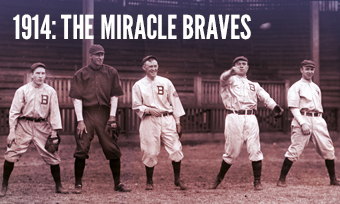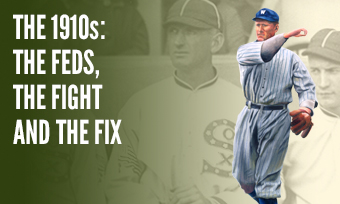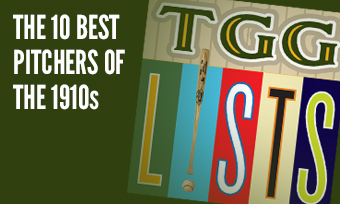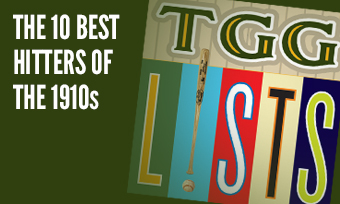The Yearly Reader
Leaders and Honors, 1914
Our list of baseball’s top 10 hitters and pitchers in both the American League and National League for the 1914 baseball season, as well as the awards and honors given to the game’s top achievers of the year.
The National League’s Top 10 Hitters, 1914
Bold type in brick red indicates league leader.
1. Sherry Magee, Philadelphia
Key Numbers: .314 average, 96 runs, 171 hits, 39 doubles, 11 triples, 15 home runs, 103 RBIs, .509 slugging percentage.
Perhaps displaying the best numbers of his stellar career, Magee was one of three Phillies—and one of four overall in the NL—to reach double figures in home runs.
2. George Burns, New York
Key Numbers: .303 average, 100 runs, 35 doubles, 10 triples, 89 walks, 62 stolen bases.
“Silent George” would be heard from as the only man other than Max Carey to lead the NL in steals between 1913-20.
3. Gavvy Cravath, Philadelphia
Key Numbers: .299 average, 27 doubles, 19 home runs, 100 RBIs, 83 walks.
The slugger exploited the short reach to Baker Bowl’s right-field wall in Philadelphia like no one else; all 19 of his home runs came at home.
4. Zack Wheat, Brooklyn
Key Numbers: .319 average, 26 doubles, 9 triples, 9 home runs, 89 RBIs.
The all-time hits leader for the Dodgers continued his gradual emergence to the point that he helped lift Brooklyn to its best record since 1903 (even if it was still a below-.500 club).
5. Beals Becker, Philadelphia
Key Numbers: .325 average, 76 runs, 25 doubles, 9 home runs, 66 RBIs.
Becker nearly made it four Phillies with at least 10 homers; eight of his nine came at home, too.
6. Joe Connolly, Boston
Key Numbers: 120 games, .306 average, 28 doubles, 10 triples, 9 home runs, 65 RBIs.
An epitome of the Miracle Braves’ flash-in-the-pan existence (see also Bill James, below), Connolly was the champions’ most effective hitter amid a short four-year career.
7. Jake Daubert, Brooklyn
Key Numbers: 126 games, .329 average, 89 runs, 6 home runs, 45 RBIs, 33 sacrifice hits, 25 stolen bases.
The repeating batting champ was accompanied by three Brooklyn teammates (among seven total in the NL) to hit over the .300 mark.
8. Heinie Zimmerman, Chicago
Key Numbers: .296 average, 36 doubles, 12 triples, 87 RBIs.
Zim continued to be a pain to opposing pitchers—but arguably an even bigger pain to everyone else, including umpires and his own teammates, for his hot temper and lackadaisical play in the field.
9. Vic Saier, Chicago
Key Numbers: .240 average, 87 runs, 24 doubles, 8 triples, 18 home runs, 72 RBIs, 94 walks.
Despite the sub-standard average, Saier made up by racking up enough walks to lead everyday Cubs players with a .357 on-base percentage, while his 18 home runs were second in the NL behind Cravath.
10. Casey Stengel, Brooklyn
Key Numbers: 126 games, .316 average, 10 triples, .404 on-base percentage.
In his second full season at Brooklyn, Stengel took the risk of shunning a multi-year contract to play for a better one the next year. The move paid off.
The American League’s Top 10 Hitters, 1914
1. Eddie Collins, Philadelphia
Key Numbers: .344 average, 122 runs, 181 hits, 23 doubles, 14 triples, 85 RBIs, 97 walks, 58 stolen bases, .452 on-base percentage.
Collins repeated his top echelon routine and finally got his due as the last recipient of the Chalmers version of the AL MVP. He didn’t get the car for winning the batting title—because he didn’t “win” it; they gave it to Ty Cobb for the reason explained in #4 below.
2. Tris Speaker, Boston
Key Numbers: 158 games, .338 average, 101 runs, 193 hits, 46 doubles, 18 triples, 90 RBIs, 77 walks, 42 stolen bases, .503 slugging percentage.
Brash as ever—and for good reason—the Red Sox’ star continued to excel even while fueling a fractured clubhouse that would soon lead to his departure.
3. Sam Crawford, Detroit
Key Numbers: .314 average, 22 doubles, 26 triples, 8 home runs, 104 RBIs, 69 walks.
The all-time triples leader tied Joe Jackson’s AL season mark of a few years earlier; 18 of his three-baggers were hit at home.
4. Ty Cobb, Detroit
Key Numbers: 98 games, .368 average, 69 runs, 11 triples, 35 stolen bases.
Though the batting title rules of the day said you had to play in at least 100 games, the AL still gave the crown to Cobb, whose season was limited to 98 games thanks to a broken thumb suffered during an attack upon a fish vendor. Under today’s guidelines, he wouldn’t be close to winning the batting title.
5. Frank Baker, Philadelphia
Key Numbers: .319 average, 84 runs, 182 hits, 23 doubles, 10 triples, 9 home runs, 89 RBIs.
Baker produced the last of four consecutive AL HR titles; he would concede a fifth straight year by sitting out from suddenly penurious A’s manager Connie Mack.
6. Tillie Walker, St. Louis
Key Numbers: .298 average, 24 doubles, 16 triples, 6 home runs, 78 RBIs.
The future live-ball slugger (he would hit 37 homers in 1922), played to the mindset of the Deadball Era for now, leading the Browns with six jacks in his breakout season.
7. Del Pratt, St. Louis
Key Numbers: 158 games, .283 average, 85 runs, 34 doubles, 13 triples, 37 stolen bases.
The second baseman led the AL in games played, but his chance to add to that by one was foiled when he was suspended for the second game of a September doubleheader. If not for that, he would have logged a consecutive-game streak of over 700.
8. Joe Jackson, Cleveland
Key Numbers: 122 games, .338 average, 22 doubles, 13 triples.
Shoeless Joe did his best to make life for what few Cleveland fans showed up tolerable as the Naps nosedived to 102 losses—thanks in large part to Federal League defections.
9. Stuffy McInnis, Philadelphia
Key Numbers: .314 average, 181 hits, 95 RBIs.
The powerless McInnis (17 home runs in 2,128 career games) collected just one to go with 95 RBIs; he remained so consistent and so well liked by A’s manager Connie Mack that he was one of the few players retained during the team’s 1915 plunge into the abyss.
10. Fritz Maisel, New York
Key Numbers: .239 average, 78 runs, 9 triples, 76 walks, 74 stolen bases.
Amid a brief six-year career, Maisel’s 74 steals in 1914 would be the most by a Yankee not named Rickey Henderson.
The National League’s Top 10 Pitchers, 1914
1. Dick Rudolph, Boston
Key Numbers: 2.35 ERA, 26 wins, 10 losses, 336.1 innings.
As Rudolph reached elite status with the Miracle Braves, Giants manager John McGraw had to be wondering, “Why didn’t you pitch like that when we had you (in 1910-11)?”
2. Bill James, Boston
Key Numbers: 1.90 ERA, 26 wins, 7 losses, .788 win percentage, 332.1 innings.
Not to be confused with Bill James, the future stats guru, this James developed into one of the game’s great one-year wonders; he won only six games before 1914, five afterward.
3. Pete Alexander, Philadelphia
Key Numbers: 2.38 ERA, 27 wins, 15 losses, 32 complete games, 6 shutouts, 355 innings, 214 strikeouts.
As he would often, Alexander showed that he could tame Baker Bowl’s hitter-happy expanses; he was 20-4 with a 1.84 ERA at his home park, on the eve of his über-dominance in the NL.
4. Bill Doak, St. Louis
Key Numbers: 1.72 ERA, 19 wins, 6 losses, .760 win percentage, 7 shutouts, 256 innings.
After a substandard debut in 1913, Doak was encouraged to try out the spitball; it was the best advice he ever took.
5. Jeff Pfeffer, Brooklyn
Key Numbers: 1.97 ERA, 23 wins, 12 losses, 315 innings.
So bad in his first shot at the majors in 1911 that even the St. Louis Browns let him go, Pfeffer’s second chance resulted in a sterling rookie effort.
6. Babe Adams, Pittsburgh
Key Numbers: 2.51 ERA, 13 wins, 16 losses, 283 innings, 39 walks.
The early superiority of Adams’ career came to an end as he endured in spite of bad support and a 21-inning performance in mid-July that took him nearly five years to fully recover from.
7. Hippo Vaughn, Chicago
Key Numbers: 2.05 ERA, 21 wins, 13 losses, 293.2 innings.
After enduring a lack of respect and playing time (32-33) over his previous six years, Vaughn began a new six-year stretch (124-77) that earned a bit more attention.
8. Slim Sallee, St. Louis
Key Numbers: 2.10 ERA, 18 wins, 17 losses, 6 saves, 282.1 innings.
Rather than try and enhance a scoring opportunity with a hit, opponents laid down 48 sacrifice bunts against Sallee in what was surely a big sign of respect.
9. Jeff Tesreau, New York
Key Numbers: 2.37 ERA, 26 wins, 10 losses, 41 starts, 8 shutouts, 322.1 innings.
For the third straight year, Tesreau (.209 opponents’ batting average) was the toughest pitcher to get a hit off of.
10. Christy Mathewson, New York
Key Numbers: 3.00 ERA, 24 wins, 13 losses, 312 innings.
In his last workhorse effort, Matty pitched over 300 innings for the fifth straight year and won at least 20 for the 12th straight—but his ERA hit 3.00 for the first time ever and he allowed a NL-high 16 home runs.
The American League’s Top 10 Pitchers, 1914
1. Walter Johnson, Washington
Key Numbers: 1.72 ERA, 28 wins, 18 losses, 51 appearances, 40 starts, 33 complete games, 9 shutouts, 371.2 innings, 225 strikeouts, 14 wild pitches.
It didn’t matter if opposing hitters represented the AL, NL or FL; Johnson remained in a league of his own.
2. Dutch Leonard, Boston
Key Numbers: 0.96 ERA, 19 wins, 5 losses, .792 win percentage.
In setting the all-time season mark for lowest ERA, Leonard showed no weaknesses via his splits; he was exceptional whether he was at home, away, pitching in spring or early fall, etc., etc.
3. Carl Weilman, St. Louis
Key Numbers: 2.08 ERA, 17 wins, 12 losses, 299 innings.
The tall (6’5”) and underappreciated southpaw had one of his few above-.500 efforts for the Browns.
4. Ray Caldwell, New York
Key Numbers: 1.94 ERA, 17 wins, 9 losses, 5 shutouts.
The tempestuous and nightlife-prone Caldwell might have been the Yankees’ first 20-game winner in three years, but he bolted from the team in mid-August and attempted to join the Federal League in a messy and ultimately legal-intensive battle that took time to untangle.
5. Harry Coveleski, Detroit
Key Numbers: 2.49 ERA, 22 wins, 12 losses, 303.1 innings.
Absent from the majors since 1910 with only 12 wins before then—all of them, it seemed, against the Giants—Coveleski made for a triumphant return in Detroit.
6. Ray Collins, Boston
Key Numbers: 2.51 ERA, 20 wins, 13 losses, 272.1 innings.
Although Dutch Leonard (above) had by far the lower ERA, Collins had more wins; it would be his last hurrah before becoming victim of an overcrowded and talented Red Sox rotation.
7. Rube Foster, Boston
Key Numbers: 1.70 ERA, 14 wins, 8 losses.
Not the Negro League founder of the same name, Foster broke onto the Red Sox’ scene as part of a short but sweet tenure.
8. Joe Benz, Chicago
Key Numbers: 2.26 ERA, 15 wins, 19 losses, 283.1 innings.
True to form with most White Sox pitchers of the time, Benz threw exceptionally well enough to be saddled with a losing record—all despite recording the AL’s lone no-hitter of the year.
9. Eddie Cicotte, Chicago
Key Numbers: 2.04 ERA, 11 wins, 16 losses, 269.1 innings.
See Joe Benz, above. No wonder White Sox owner Charles Comiskey went out and grabbed Joe Jackson and Eddie Collins for the following season.
10. Hooks Dauss, Detroit
Key Numbers: 2.86 ERA, 18 wins, 15 losses, 302 innings.
The Tigers wisely locked the young right-hander up when the Federal League came calling, as he delivered with his initial workhorse campaign and long lifespan (through 1926) with Detroit.









